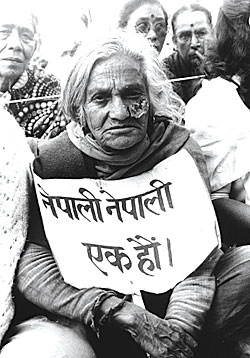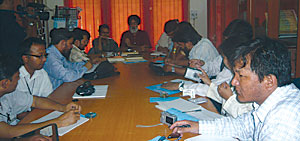 MIN RATNA BAJRACHARYA |
The provision of reservations in India did not alleviate poverty and end oppression, it gave birth to a new elite class within the community. Experts on reservation social complexities must be understood before introducing reservation in a multi-cultural country. In Nepal, there are 100 ethnic, 92 linguistic groups and nine religions. The list might even
increase with the rise of identity politics in the country.
One of the key issues is that there are sub-groups within groups (women, Janajatis, Madhesi, Dalits, the disabled and underprivileged regions). For instance, within the Madhesi community there are Muslims, Dalits and Janajatis.
There are six Pahadi Dalits, 14 Madhesi Dalits and five Newar Dalits. There are 59 groups in the government classification of indigenous nationalities.
There is a 'poor class' within each linguistic, ethnic and regional community. Affirmative action is supposed to uplift them, but what may look workable in the beginning may turn out to be infeasible as it has in India.
Dalit activist and director of the Indian Institute of Dalit Studies, Surendra Singh Joharwa says: "The issues we overlooked 50 years ago have become crucial now. Nepal should do its homework on identifying the issues and circumstances first so that it won't regret the move like we do now."
Reservations for ethnic communities in India gave rise to an affluent class instead of alleviating poverty. The proponents of reservation consider this an achievement but it did not change the lives of the poor families. Director of Indian Social Institute Mariyanas Dhabi says: "We should identify the gap between the oppressor and the oppressed, but politically allotted quotas will never bring the desired results."
In India, there are 403 seats in parliament of which 80 are allotted to Dalits. But it has taken India 50 years to understand that the poverty knows no caste. Chief minister of Uttar Pradesh Mayawati is a Dalit and has been elected four times, but the condition of Dalits in her state has not improved. Lucknow may be thriving, but the nearby Dalit settlement of Ompur is no better than it was.
Tamil Nadu fares no better. Out of 60.25 million people in that southern state, 20 per cent are Dalit. The Indian constitution has reservations for only Hindu Dalit but the poor non-Hindu Dalits are deprived of reservation even though Dalits remain Dalits no matter what religion they follow. In Chennai, Father Bhanu warns: "No one should make this mistake of allotting a quota on the basis of religion and caste."
The commercialisation of the economy has decreased the opportunities in public service but it has increased poverty at the same time. In 1991, the Indian government had vacancies for 4.3 million positions, in two years that dropped to 3.8 million. In 1991 70 per cent of Dalits were landless, by 2000 that had leapt to 75 per cent.
Reservation could actually be a political weapon for those who do not want change. It is easy to gather votes by bandying around the slogan of reservation.
In Nepal, Janajatis have been demanding proportional representation. Of Nepal's population, 37.8 per cent are Janajatis, but 33.39 per cent of CA members are Janajati. On the other hand, Madhesis make up 31.2 per cent of the population but have 34.9 per cent representation in the CA. Dalits make up 13 per cent of the population but have only 8.17 per cent representation. Similarly, 51 per cent of Nepalis are women, but they have only 33.22 per cent representation in the CA.
But after 50 years of reservation, India doesn't even have the representation of mraginalised comunites that Nepal already has in its legislature. In Delhi, Jawaharhal Nehru University professor Sikha Deb Thorat says, "The world can learn a lesson from Nepal that the change is possible through political consciousness and people movement."
Learning from India's mistake
 PANOS SOUTH ASIA |
Jagaran Media in association with Panos South Asia took a 21 member team of CA members, journalists, intellectuals and rights activists on a study tour to four states in India, Uttar Pradesh, Delhi, Maharastra and Tamilnadu. Conclusions of a meeting between a delegation of Nepali Dalits with the Indian National Human Rights Commission last year in New Delhi:
It would be a grave error to not include the economic, social and cultural rights of marginalised communities as fundamental rights in the constitution. To recognise these rights only as 'directive principles' of the state like it is done in the Indian constitution does not go far enough.
Thus far only the civil and political rights of Dalits have been enshrined as fundamental rights. Their social, economic and cultural rights can only be recognised by law if they are enshrined as fundamental rights within the constitution.
Outlawing discrimination is not enough. Affirmative action with a certain number of seats guaranteed for the marginalised is one of the best ways of ensuring marginalised communities are fully represented. These seats should be decided by proportional representation. Such guarantees should extend beyond government to the private sector.
It should also be mandatory that people from marginalised communities take part in implementing this law. They should seek executive roles in politics by lobbying political parties and submitting written suggestions to the CA.
As far as is practicable, a separate constituency should be created for Dalits in the places where they form a majority. Ambedkar proposed this to ensure Dalit representation in the election. In such constituencies, the preliminary election is conducted among Dalit candidates and with Dalit voters only. In the final election voters from other communities can participate.
This was practised in a few constituencies of India's Uttar Pradesh and Madhya Pradesh in the 1937 election. Ambedkar's party won 13 MPs in this way. But Gandhi objected to the practice and later dropped it. A dual voting provision to take into consideration the sensibility of non-Dalit candidates was agreed on by consensus. Under this agreement, Dalits can cast two votes?for Dalit and non-Dalit candidates. But even if a Dalit candidate won it was the non-Dalit high castes that ultimately got hold of power. Nepali Dalits should take note of this.


